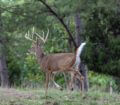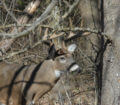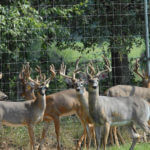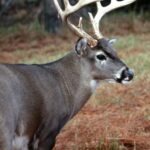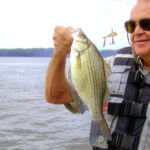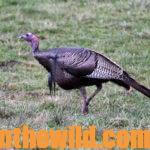John’s Note: Finding and taking a big deer is a process of connecting the dots with the knowledge you’ve learned from people who consistently take big bucks. Sure, some of the hunters who bag big deer just got lucky. But others have put together tactics that regularly produce trophy bucks. See if you can connect the dots this week of these featured deer hunters.
 If you blow a hunt, you still may be able to take that buck, even if you’ve spooked him. If you know the land where you’re hunting and have a good idea of where that buck will show up next, you still may get a second chance to take that buck of a lifetime. That’s what happened to Raymond Hoverson of Atchison, Kansas.
If you blow a hunt, you still may be able to take that buck, even if you’ve spooked him. If you know the land where you’re hunting and have a good idea of where that buck will show up next, you still may get a second chance to take that buck of a lifetime. That’s what happened to Raymond Hoverson of Atchison, Kansas.
Hoverson started deer hunting in 1999. “I owned a farm in Doniphan County, Kansas, but we didn’t have many deer there back in the 1990s. We did have good goose and pheasant hunting. When I married my wife, Cindy, her farm was farther south than mine, with completely different terrain, including timber, bluffs, valleys and creeks. There were deer to hunt on Cindy’s land.
“Today we hunt 160 acres of timber on my wife’s farm with row crops on one side and high steep bluffs belonging to a neighbor on the other side. The bluffs drop off into a creek bottom that holds the timbered area where I hunt. The deer often live and bed in those high bluffs, come down into the creek bottom and the timber and travel through that timber to reach our row crops. In 2007 when I took the Over-the-Hill Buck, we had soybeans planted in our field that we had cut. Every year we raised corn, soybeans and hay for our cattle. The temperature was only 10 degrees and with the wind-chill factor was below zero.”
Hoverson got into his ground blind at about 5:30 am and waited for daylight with the wind coming out of the north. Hoverson expected the deer to come from the bluffs behind him, cross the creek and go out into the soybean field to feed, since he’d been seeing deer along the skyline of the bluffs and then moving over into the timber. “I spotted a herd of 15 deer, including an 8 pointer that would score about 180 inches, just at daylight, coming over the top of the bluff,” Hoverson remembers. “Since I was upwind of the deer, they stopped. I was sure they smelled me. The big buck at the back of the herd was visible for only an instant. The entire herd whirled and went back over the bluff.”
Knowing the deer had to feed that morning, Hoverson assumed the herd would move down the backside of the bluff and then try to come back over the bluff again closer to the field. Because he knew the property so well, he also had created a second blind on the trail closest to the soybean field. He quickly gathered up his equipment, including his Remington (https://www.remington.com) .30-30 bolt-action rifle.
“I like the .30-30 because it’s a great brush gun,” Hoverson says. “If I have to shoot though brush, I know that caliber will penetrate the brush and put a buck down.” Hoverson moved slowly and quietly down the hill to take a stand at his second blind, hoping he could arrive before the herd of deer reached the trail he thought they’d take that led to the soybean field. “I only had been in my stand for about 15 minutes, when I spotted the herd walking single file down to the trail that led to the soybean field,” Hoverson explains. “Each deer passed within 45 yards of my blind, but the big buck never showed.”
After the herd moved out into the field to feed, Hoverson waited another 45 minutes in his ground blind. “I assumed the buck was spooked so badly that he would return to the west or wait until the herd reached the soybean field and started feeding and moving, once he thought it was safe,” Hoverson reports.
Although Hoverson had trail cameras at several locations, he never had gotten a picture of the monster buck he spotted at first light. Hoverson did have an easy 45-yard shot at an 8-pointer, scoring about 140. While waiting on the big buck to show up, Hoverson second guessed himself, wondering if he shouldn’t have taken that 8 pointer when he came down the trail 45 yards in front of him. “However, the big buck was in the back of the herd, and I only could see his rack before he spooked,” Hoverson says. “I knew I’d done the right thing. But I wondered if I’d ever see that monster buck again.”
Finally Hoverson’s patience was rewarded. He saw the big buck above him on the same trail that the rest of the herd had used to come down off the bluffs to move into the field. Hoverson had gotten downwind of the herd and hadn’t spooked any of the deer as they went to feed. “When I spotted my dream buck on the trail to the field, he had his nose in the air smelling upwind, to see if he could pick up my human odor from the ground blind I’d been in earlier that morning.”
Before deer season opened, when Hoverson was setting up his two blinds, he’d trimmed shooting lanes about 70-yards long and 10-yards wide in the timber, giving him two lanes that provided him with a clear shot. At the end of each shooting lane was about a 10-foot opening. Once Hoverson spotted the big buck, he got his rifle up on his shoulder and waited on the buck to come down the trail and cross into his shooting lane. As the buck approached, Hoverson got his cheek against the stock of his rifle and readied for the shot. “When the big buck stepped out into that shooting lane, I aimed about 10 inches behind his shoulder and squeezed the trigger,” Hoverson recalls. “I knew I’d made a good hit on the buck. But to my surprise, the buck didn’t move. Then suddenly, the buck ran about 15 or 20 yards and went down.”
 Hoverson remained in his ground blind, reloaded and waited to make sure the buck didn’t get back up. He thought to himself, “I’ve just taken a really nice buck. Although I didn’t know how many points the buck had, I knew his rack was wide, thick, tall and chocolate covered.” When Hoverson left his blind, walked to his buck and grabbed hold of that massive rack, he said to himself, “This buck is the one I’ve been hunting for all my life.”
Hoverson remained in his ground blind, reloaded and waited to make sure the buck didn’t get back up. He thought to himself, “I’ve just taken a really nice buck. Although I didn’t know how many points the buck had, I knew his rack was wide, thick, tall and chocolate covered.” When Hoverson left his blind, walked to his buck and grabbed hold of that massive rack, he said to himself, “This buck is the one I’ve been hunting for all my life.”
* BTR Score – Buckmasters’ Composite Score – Number of Inches: 198-5/8
* Official Buckmasters’ Score: 178-6/8 (doesn’t include inside spread of main beams)
To learn more about hunting deer, see John E. Phillips’ eBooks and print books at www.amazon.com/author/johnephillips and www.barnesandnoble.com. John’s newest deer-hunting book, “Whitetail Deer and the Hunters Who Take Big Bucks” is available at http://amzn.to/2bYwYOK/.

